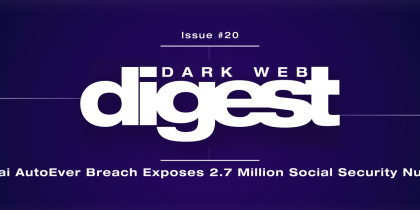Your email could be compromised.
Scan it on the dark web for free – no signup required.
Your Browser Just Got a Side Hustle (And You’re Not Getting Paid)
In this edition of Dark Web Digest, we uncover a stealth cryptojacking campaign that has compromised over 3,500 websites globally. This isn’t some flashy ransomware or obvious pop-up scam. It’s quiet. It’s persistent. And it’s happening in the background while you read the news, browse e-commerce sites, or check job listings.
This isn’t just about crypto mining. The same infrastructure powering these stealthy scripts has a shady history. Researchers have linked it to Magecart card-skimming operations, where threat actors inject fake payment forms into e-commerce checkout pages, especially those built on the OpenCart CMS in East Asia.
Unsuspecting shoppers enter their credit card details, thinking it’s a legitimate transaction. But behind the scenes, that sensitive info is silently siphoned off to attacker-controlled servers — often ending up for sale on dark web marketplaces.
So, not only could your device be unknowingly mining crypto…
It might also expose your financial details if you land on the wrong site.
TL;DR: What You Need to Know
- Attack Scale: Over 3,500 websites infected with crypto mining JavaScript.
- Attack Method: Obfuscated JavaScript + Web Workers + WebSockets for dynamic crypto mining.
- Tactics: Mines crypto silently, throttles load to avoid suspicion, and evades detection.
- Target: Anyone visiting infected websites (aka, probably you).
- Victim Websites: Mostly WordPress-based, OpenCart e-commerce platforms, and others.
- Financial Risk: Attackers can steal payment info, skim card details, and even leak credentials that may lead to fraud or identity theft. Stolen data is often sold on the dark web, exposing you to long-term financial damage.
- Device Risk: Machine wear-down, performance drain, identity risk if combined with other payloads.
- Dark Web Tie-in: Same infrastructure linked to Magecart card-skimming campaigns.
- Dark Web Exposure Tip: Run a free and quick Dark Web Exposure Scan to see if your info is at risk.
What Happened?
Security researchers uncovered a massive, global cryptojacking operation that infected over 3,500 websites. At the heart of it: an obfuscated JavaScript miner that hijacks your CPU power to mine cryptocurrency in the background — with you none the wiser.
It gets worse.
This isn’t a “run once and vanish” script. It uses Web Workers to split the mining job into smaller tasks and WebSockets to adjust power usage based on your device, keeping everything hush-hush. No browser alerts, no fan screams — just a silent siphon of your machine’s energy.
It’s adaptive, throttled, and so sneaky that most users (and even security tools) miss it.
And that’s the real threat: it’s not flashy. It’s functional.
What Kind of Attack Is This?
This isn’t ransomware or phishing. It’s “cryptojacking” — stealing your processing power to mine digital coins. And it’s evolved:
- Stealth mining via browser JavaScript
- Dynamic throttling to evade suspicion
- WebSocket communication to avoid URL-based blockers
- Infrastructure reused for other attacks
Basically, this attack is designed to sit quietly, make money, and stay invisible.
What Makes This Attack So Stealthy — and So Profitable on the Dark Web?
This isn’t your average smash-and-grab hack. It’s a slow-burn operation built to stay invisible while quietly profiting from your device, data, and traffic.
- Web Workers break up mining tasks into smaller background jobs, avoiding performance spikes.
- WebSockets silently connect to attacker servers, bypassing traditional blockers and detection tools.
- Device-aware mining ensures CPU usage stays just low enough to avoid suspicion.
But the stealth doesn’t stop at mining…
This campaign reuses the same infrastructure seen in:
- Magecart-style card skimming: stealing credit card and payment data.
- Fake login forms: used to harvest credentials for resale on dark web forums.
- Spammy SEO injections: infecting websites with shady redirects that push visitors toward phishing sites or malware.
All of these tactics have one destination:
Dark web marketplaces where stolen identities, credit card dumps, and breached accounts are traded like commodities.
- Crypto Drain: Your power is used to mine digital currency — but the earnings? They fund cybercrime ecosystems.
- Credential Harvesting: Your login or card info may already be circulating in breach dumps.
- Browser Hijacks: Your clicks and search rankings are hijacked to boost malicious actors’ reach — and their profits.
- Spam SEO Injection: Turns your favorite sites into infection hubs, unknowingly serving visitors malware or phishing traps.
This isn’t a hit-and-run. It’s drip mining, drip stealing, and drip selling — a stealth business model that thrives in the shadows of the dark web.
Why This Campaign Is a Wake-Up Call
This isn’t just about a slower laptop or a hot browser tab.
It’s a signal that cybercriminals are evolving quietly — and cashing in on the dark web.
This is a reminder that:
- Any website can be weaponized — from blogs to e-commerce stores. Even that niche forum you casually visit.
- Infrastructure reuse = layered attacks — the same script that mines crypto might also skim credit cards or steal your credentials.
- Your system degrades over time — fans run louder, batteries die quicker, and performance drops… but you’ll never trace it to a background miner.
- A single visit can trigger it all — a quick click to the wrong site and suddenly your device is pulling double duty: mining crypto and leaking your data.
And here’s the kicker:
These miners aren’t acting alone.
They’re bundled with card skimmers, SEO spam, backdoored plugins, and fake login pages — all designed to harvest your data and flip it on dark web marketplaces.
It’s not just stealthy. It’s scalable cybercrime — engineered to profit from every digital footstep you take.
Read more: The Intersection of Cryptocurrency and Cybersecurity: What You Need to Know
Check If Your Data Is Already on the Dark Web
Crypto mining is just one layer. Many of these infected websites are also tied to Magecart — which means stolen credit cards, fake forms, and stolen credentials.
So before you shrug this off…
Run a free PureVPN’s Dark Web Exposure Scan (already linked above)
It checks if your email appears in recent breaches and shows a snippet of exposed data — all in under 30 seconds.
You’ll instantly know:
- If your data is already on dark web marketplaces
- How recent the exposure was
- How many breaches have involved your info
Start your scan. Stay ahead of identity theft.
Real-World Threats You Should Prepare For
These attacks might seem invisible — until they aren’t:
- Device Performance Drain: Slower systems, battery drain, overheating
- Browser Exploits: Coupled with zero-day scripts to compromise more than just power
- Phishing + Skimming: Some sites serve fake login or checkout pages as well
- Data Abuse: If credentials are stored in browser autofill, attackers may grab those too
What You Can Do Right Now
- Use a VPN: Hide your browsing activity and protect against script injections using a premium VPN like PureVPN.
- Install a Script Blocker: Tools like uBlock Origin or NoScript can detect WebSocket use
- Secure Your WordPress Site: If you’re a site owner, monitor plugin installs and file changes
- Adopt a Paranoid Mindset (in a good way): If a site behaves oddly — slow loads, spinning fans — trust your gut
- Scan for Malware Frequently: Background mining often comes with bonus infections
What’s Next & Why You Should Subscribe
This campaign isn’t over. It’s stealthy. It’s spreading. And it’s likely being monetized in ways we don’t yet fully see.
The internet is being weaponized — quietly.
This stealthy crypto-mining wave shows how attackers are going low and slow, blending into legitimate infrastructure. Dark Web Digest keeps you a step ahead with real-time alerts, breakdowns of new tactics, and free tools that actually help.
By subscribing to Dark Web Digest, you’ll:
- ⚠️ Early warnings on breaches before they go mainstream
- 🔎 Expert breakdowns in plain language
- 🛡️ Free tools to determine dark web exposure to stay ahead
We break it down, so you can lock it down.
Note: Information in this newsletter is based on publicly available sources as of July 22, 2025.








